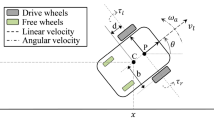Abstract
The Immune System is a complex adaptive system containing many details and many exceptions to established rules. Exceptions such as the suppression effect that causes T-cells to develop reversible aggressive and tolerant behaviors create difficulties for the study of immunology but also give hints to how artificial immune systems may be designed.
Presented in this paper is the General Suppression Framework, which models the suppression hypothesis of the immune discrimination theory. A distributed control system based on the proposed framework is designed to control a modular robot configured into a planar manipulator arm. The modules can generate emergent group behaviors by exhibiting aggressive or tolerant behavior based on the environment change. A MATLAB simulation program is developed to demonstrate the effectiveness of the suppression mechanism and a mechanical arm is constructed to verify the control actions of the mechanism. The ultimate ambition of this work is to understand how the suppression mechanism affects the discrimination system and in turn affect other integral parts of the artificial immune system.
Access this chapter
Tax calculation will be finalised at checkout
Purchases are for personal use only
Preview
Unable to display preview. Download preview PDF.
Similar content being viewed by others
References
Benjamini, E., Sunshine, G., Leskowitz, S.: Immunology: A Short Course. Wiley-Liss, New York (1996)
Bentley, P.J.: Evolution Design by Computers. Morgan Kaufmann, Bath (1999)
de Castro, L.N., Timmis, J.: Artificial Immune Systems: A New Computational Intelligence Approach. Springer, New York (2002)
Dasgupta, D.: Artificial Immune Systems and Their Applications. Springer, Germany (1999)
Hassoun, M.H.: Fundamentals of Artificial Neural Networks. MIT Press, Cambridge (1995)
Ivanescu, M., Bizdoaca, N.: A Two Level Hierarchical Fuzzy Controller for Hyperredundant Cooperative Robots. In: Proc. of the IEEE Intl. Conf. on Robotics & Automation (2000)
Kimura, S., Takahashi, M., Okuyama, T.: A Fault-Tolerant Control Algorithm Having a Decentralized Autonomous Architecture for Space Hyper-Redundant Manipulators. IEEE Transaction on Systems Man, and Cybernetics-Part A: Systems and Humans, 28(4), 521–528 (1998)
Ko, A., Lau, T.L., Lau, H.Y.K.: Topological Representation and Analysis Method for Multi-port and Multi-orientation Docking Modular Robots. In: Proc. of the IEEE Intl. Conf. on Robotics & Automation (2004) (to appear)
Lau, H.Y.K., Wong, V.W.K.: Immunologic Control Framework for Automated Material Handling. In: Proc. of the Intl. Conf. on Artificial Immune Systems (2003)
Playfair, J.H.L., Chain, B.M.: Immunology at a Glance. Blackwell Science, Bodmin (2001)
Ray, T.S.: Overview of Tierra at ATR, in Technical Information, no. 15, Technologies for Software Evolutionary Systems, ATR-HIP (2001), http://www.isd.atr.co.jp/~ray/pubs/overview/Overview.doc
Segel, L.A., Cohen, I.R.: Design Principles for the Immune System and Other Distributed Autonomous Systems. Oxford University Press, Oxford (2001)
Sharon, J.: Basic Immunology. Williams & Wilkins, Pennsylvania (1998)
Sipper, M.: Machine Nature: the Coming Age of Bio-inspired Computing. McGraw-Hill, New York (2002)
Sompayrac, L.: How the Immune System Works, p. 99. Blackwell, Massachusetts (1999)
Tarakanov, A.O., Skormin, V.A., Sokolova, S.P.: Immunocomputing: Principles and Applications. Springer, New York (2003)
Vinge, V.: A Fire Upon the Deep. Tor, New York (1992)
Wooldridge, M.J.: An Introduction to multiagent systems. John Wiley & Sons, West Sussex (2002)
Author information
Authors and Affiliations
Editor information
Editors and Affiliations
Rights and permissions
Copyright information
© 2004 Springer-Verlag Berlin Heidelberg
About this paper
Cite this paper
Ko, A., Lau, H.Y.K., Lau, T.L. (2004). An Immuno Control Framework for Decentralized Mechatronic Control. In: Nicosia, G., Cutello, V., Bentley, P.J., Timmis, J. (eds) Artificial Immune Systems. ICARIS 2004. Lecture Notes in Computer Science, vol 3239. Springer, Berlin, Heidelberg. https://doi.org/10.1007/978-3-540-30220-9_8
Download citation
DOI: https://doi.org/10.1007/978-3-540-30220-9_8
Publisher Name: Springer, Berlin, Heidelberg
Print ISBN: 978-3-540-23097-7
Online ISBN: 978-3-540-30220-9
eBook Packages: Springer Book Archive




